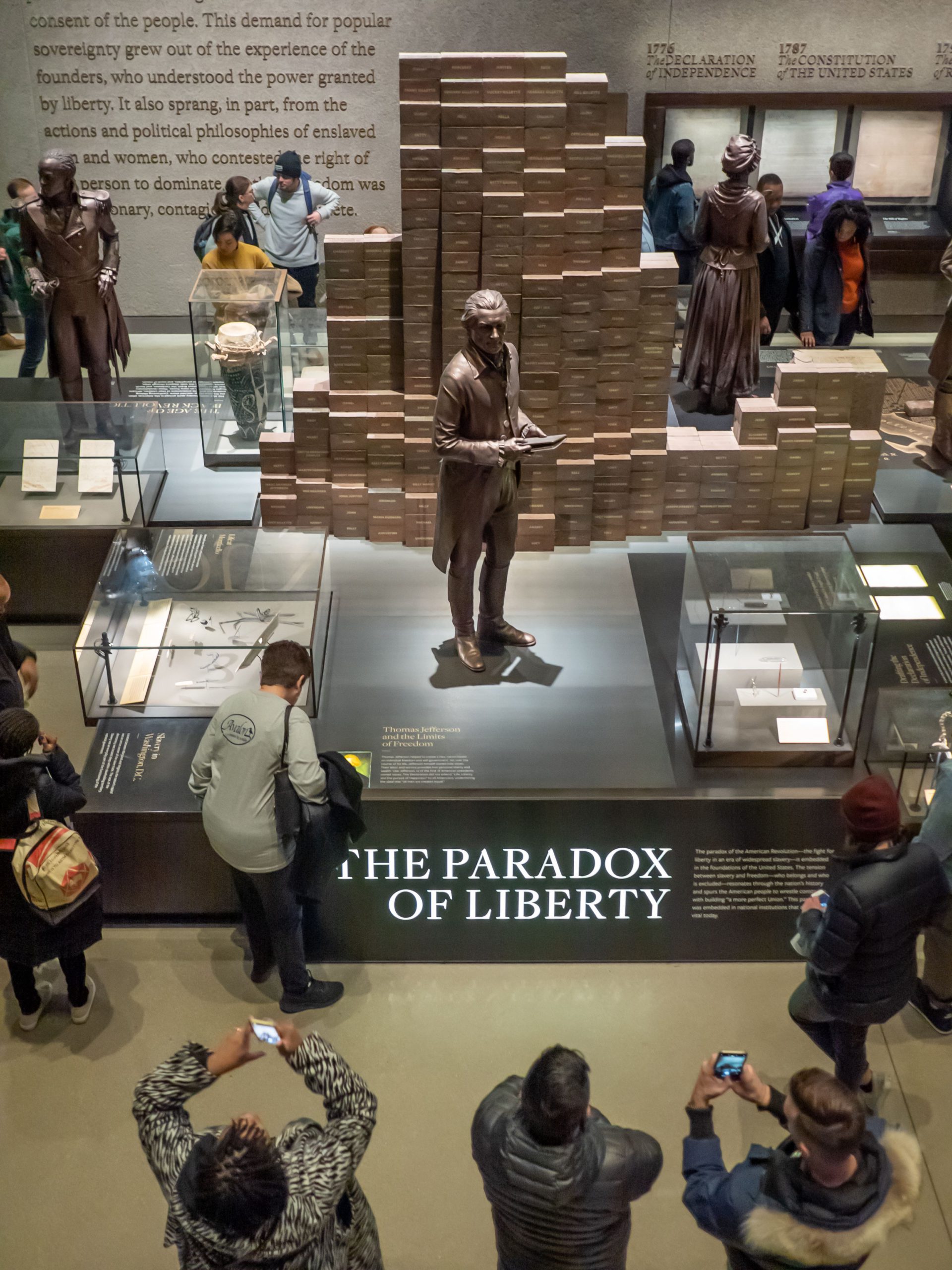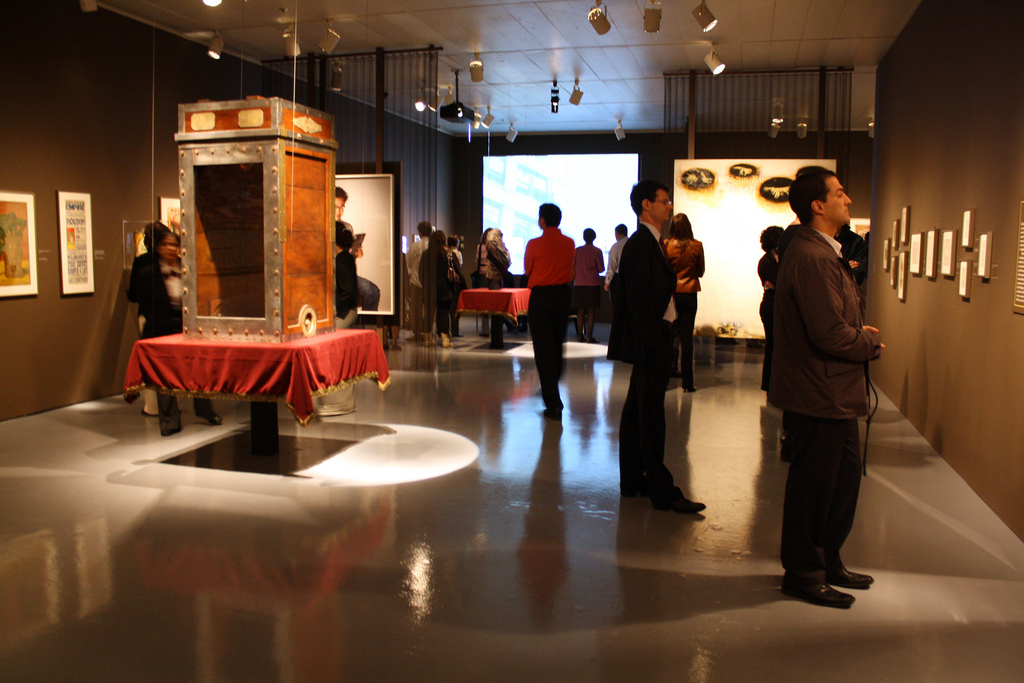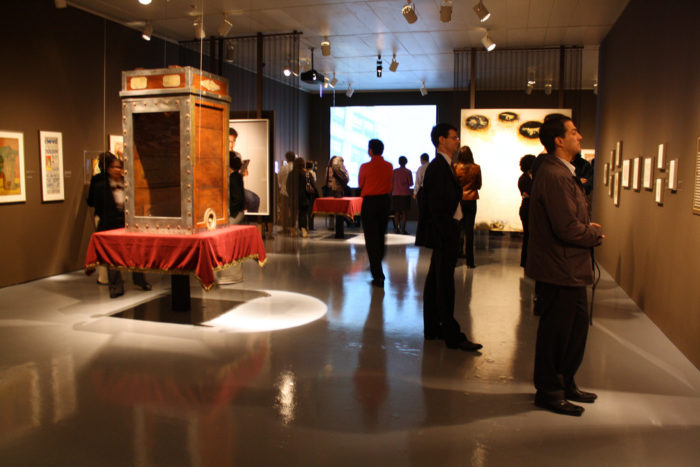
Exhibitions are about creative visual storytelling. More than just history put up on the walls, they are metaphors, visual poetry, and imagination that spark curiosity and broaden our understanding rather than limiting it. The juxtaposition of objects, graphics, and photographs and the creative interjection of re-created spaces and interactive devices all contribute to the viewer’s ability to place themselves within a particular place and time or to understand a historical concept. People in the past did not live their lives in isolation, but rather acted in ways that affected the lives of others—not only those in their communities, but others far afield. To understand history—and to understand our communities—the exhibitions we create must explain these complicated relationships, creating more inclusive, and also more accurate, experiences for visitors.
How well you can connect with your audiences—and how well you can hold their attention—depends both on your abilities as a visual storyteller and how effectively you have engaged your community’s stakeholders. How can you involve your community in the exhibition development process? Have you considered asking community members what stories might make good exhibitions? Do you have advisory boards or partners that assist in determining approaches to your exhibition ideas? These questions are particularly important as you foster a community-focused institution that explores the history of people who may have been excluded from your museum or whose stories have not been part of the local written record.
Creative Visual Storytelling
Instead of approaching an exhibition as an essay or a textbook, visual storytelling is about creating drama and enabling the story to unfold as an experience for the eyes as well as the mind. Visual stories often highlight people who witnessed the events being chronicled. A human component is key; contemporary history museums should generally avoid solely object-based exhibitions that lack human narratives. Visual storytelling is about finding the right window into the dense research required when composing a history, a window that can both contextualize the story for the viewer and complicate it in ways that make it authentic. At the same time, visual storytelling must be simple enough to avoid being a book on the wall yet complicated enough to be comprehensive.
The National Museum of African American History and Culture tells the story of the founding of the nation through the lens of slavery. The exhibition highlights the lives of enslaved and free people in different parts of the country and in differing circumstances. Under the heading “The Paradox of Liberty,” it explores the experiences of Black Americans who seized on the Revolution’s rhetoric of liberty and freedom to argue against slavery and probes the contradictions of Thomas Jefferson, an enslaver who authored the Declaration of Independence. Viewed through this lens, the story of American slavery and the founding of the United States has depth and deeper meaning. Slavery was a complex institution and despite being a moral evil was maintained for so long because of its economic rewards for many individuals as well as white enslavers’ sincere belief in their own superiority. Revolutionary ideals nevertheless contributed to growing antislavery and abolitionist movements throughout the Atlantic World.
As historian and curator Fath Davis Ruffins discusses in her foundational essay, “The Exhibition as Form: An Elegant Metaphor,” a good exhibition is a nonlinear form of cultural argument that has physical form and structure. But it is also an interpretation, one visual aspect of the past. It is a metaphor—well researched and visually told.[i] The best exhibitions are inclusive visual stories that help visitors to connect, in some way, with bigger ideas through the materials shown.
Exhibition-based Collecting
It is impossible to talk about exhibitions in museums without discussing how and what they collect. Museums draw their exhibitions from their collections and often base their research on those collections; yet, the artifacts in most history museums are not representative of a broad spectrum of their audiences. Most of the artifacts locked away in storage rooms primarily represent the history of people of great wealth, the history of the white founders of the museum or its community, or the quirky taste of an individual collector. Thus, the objects available for exhibition often reflect a fairly narrow demographic. The factors that limit collecting and research also limit exhibitions. Many museum staff will argue, “we want to do an exhibition on this or that history, but we just don’t have the collections.” This is not an acceptable excuse for choosing not to do more inclusive exhibitions. If museums wish to tell more inclusive stories, they may need to begin the exhibition process with a collecting initiative, actively seeking to add artifacts to the collection that represent different voices.

Exhibition-based collecting is one way to enhance the artifacts owned by a museum, making their collections more inclusive and at the same time providing the foundation for exhibitions that explore history more broadly. Launching an exhibition-based collecting project enables institutions to develop focused cross-cultural collections that they know will be used for public display rather than simply filling storage closets. One way to begin identifying ideas for more inclusive exhibitions is to select those topics that cross ethnic, racial, and cultural barriers—the stories and experiences that human beings share, but perhaps in different ways. Cross-cultural projects help to build understanding between and among community groups. Rites of passage, for example—birth, death, marriage/joining, and coming of age stories provide excellent fodder for exhibitions. Topics related to food or drink, clothing and adornment, and race and religion also lend themselves to such inclusive collecting. Exploring abstract ideas, such as home, freedom, faith, democracy, social justice, or mobility, enables museums to dive into core values and ideas in history, and to look at them through the different lenses of their various communities.
Teenage New Jersey, an exhibition and collecting project of the New Jersey Historical Society, is a perfect example of a topic that enabled a museum to create a more inclusive collection in a focused manner.[ii] Two years before the opening of the exhibition, the museum put out a call for collections related to teenage life in the state. They gathered stories about the teenage experience and asked their constituents what was important about being a teenager in New Jersey and what stories should be told. The museum staff specifically targeted certain communities to ensure their ability to tell a diverse story across time. They visited urban and rural communities, beach towns “down the shore,” suburban high schools, and high schools in predominantly black communities. They learned about the importance of beach culture, diners, sports, and music to New Jersey teens. But most importantly, they discovered, whether you loved or hated high school, that the topic of teenage life offered visitors an opportunity to connect across generations, genders, and ethnic and racial groups. Visitors engaged in conversations in the galleries about the things that matter to teenagers and those who care for them. Some teenage visitors realized that their parents had once been in high school and could indeed understand their struggles. The exhibition reminded parents of their own teen experiences. The stories of teenage life in New Jersey became a way to create understanding whether you had grown up after World War II with Frank Sinatra and Sarah Vaughan or in the 1980s with Bruce Springsteen and Queen Latifah. Enhanced visibility proved to be an additional benefit of the Teenage New Jersey collecting and exhibition project. The Chicago History Museum expanded the idea with a Teenage Chicago exhibition that also included an oral history collecting program.
Reinterpreting Collections
Reinterpreting collections in storage can also bring a more inclusive approach to an exhibition program, although it is not a substitute for active collecting to redress the limitations of a museum collection. The Oakland Museum of California took a traditional object owned by just about every history museum—wedding dresses—and created a dynamic exhibition that provided visitors with a deeper understanding of their state and its people. Weddings California Style created vignettes of the wide variety of weddings that have taken place in the state. The exhibition included a few of the traditional white wedding dresses they already owned, supplemented with others that were gathered for the exhibition. The curators included a series of vignettes that documented the way that Californians celebrated their life partners. They included a broom-jumping ceremony, a gay wedding, and a Chinese wedding, among others. Describing a wedding in a Japanese internment camp, for example, provided an opportunity to consider how people survive in the face of tragedy and reminded visitors that understanding history is not simply about celebration. The breadth of their story provided visitors with an understanding of the wide variety of people and traditions in California, as well as more complex stories about the state’s history.
That exquisite mahogany chair in the collection, long used to represent the lifestyle of the wealthiest family in town, can also be reinterpreted to assist visitors in looking more critically at objects. That chair takes on new meaning in a story about conspicuous consumption, about the destruction of trees in the Caribbean, about the slave trade, or about dangerous occupations.[iii] Such topics also can make contemporary connections for visitors that an artifact displayed simply as a beautiful antique chair cannot. Similarly, the accoutrements of tobacco, chocolate, coffee, and tea so common in museum collections can be interpreted in ways that complicate their stories and create more inclusive narratives.
Rapid Response and Contemporary History
Developing a plan for rapid-response collecting provides a way for museums to document significant community events as they are happening—or soon after they happen—and provides fodder for exhibitions on contemporary issues. Although every opportunity for rapid response collecting may not support more inclusive storytelling, the practice is designed to ensure that the artifacts needed to tell a community’s stories are available when needed for exhibitions in the future. Does the museum have a plan to collect the political paraphernalia from candidates following a local election so that it will not be lost? Are there local communities whose history should be documented? Is there a process for identifying, collecting, and exhibiting the stories of local tragedies as well as triumphs? What are the contemporary local stories that the institution anticipates might be important to tell in the future? The Victoria and Albert Museum’s well-developed rapid response collection program identifies artifacts for exhibition that represent “major moments in history that touch the world of design and manufacturing.” Tied closely to their mission, this new initiative includes objects like the Tampax cup, a pussy hat from the 2017 Women’s March, and a personal DNA test kit. Florida’s Orange County Regional History Center created a rapid-response collection and exhibition following the Pulse Night Club shooting in 2016, which was the United States’ deadliest mass shooting to that date. The goal of the project was to gather objects left at memorials or donated to the museum and to “assist our community in both its grieving and healing,” the curators noted.[iv] Like the museum in Orange County, museums can provide space for their visitors to grapple with difficult issues that affect their lives or have affected their communities in the past—mass shootings, fracking, the removal of Indigenous people, segregated schools and neighborhoods, homelessness, food insecurity, urban renewal, housing, global warming, or police violence.
Dialogue
We can use exhibitions as a way to initiate dialogues between the museum and our visitors as well as conversations among the different people who live in our communities. The best exhibitions include multiple voices with images that represent different points of view. Sharing curatorial control with community stakeholders can often provide new ways of looking at objects and telling stories. Exhibitions can thus become the catalysts for facilitated museum conversation programs that address ideas or problems that matter in people’s lives and demonstrate the museum’s essential role. Perhaps more than any other action, engaging the perspectives and input of the community makes for a more inclusive approach to exhibitions.
Conclusion
Twenty-first century museums cannot just continue to tell the stories found in the old histories of their towns. Visitors want more. They want to see things that relate to their lives and they want to see their histories told in the museum. Museums must demonstrate that they are relevant and that there is a reason that they deserve their tax-exempt status—in other words, that they perform a useful service for all of the people who live within their borders, not just an elite few. To do this requires hard work, research into new sources, and talking with the people whose stories have been left out—engaging those people in the storytelling. There are no longer Indigenous people or African Americans in your town, you say. What can you do to find out why? Can the historians at the local or regional university help you to find people nearby who can help you identify sources and people who know the stories? Historian Craig Wilder notes that “Americans like to celebrate their history, but we don’t like to look at it very closely.”[v] We tend to ignore the stories of pain and focus on the stories of triumph. But the stories that demonstrate how we have failed to live up to our values can often be the most valuable and instructive, and they can make us better citizens.
Notes
[i] Fath Davis Ruffins, “The Exhibition as Form: An Elegant Metaphor,” Museum News 64, no. 1 (October, 1985): 54-59.
[ii] For a review of the exhibition, see Michael Birkner, “Remembrance of Good Times: Teenage New Jersey,” Winterthur Portfolio 34, no. 2/3 (Summer-Autumn, 1999), https://www.jstor.org/stable/1215346.
[iii] See, for example, Jennifer Anderson, Mahogany: The Cost of Luxury in Early America (Cambridge: Harvard University Press, 2012).
[iv] Pam Schwartz, Whitney Broadaway, Emilie S. Arnold, Adam M. Ware, Jessica Domingo, “Rapid-Response Collecting after the Pulse Nightclub Massacre,” The Public Historian 40, no. 1 (February 2018): 106. See also, “LGBTQ Public History: Reports from the Field,” digital publication, National Council on Public History, October 2019, https://ncph.org/wp-content/uploads/2019/10/LGBTQePubOct212019FINAL.pdf; and, Melissa Barthelemy, “Documenting Resilience and Community Healing in Orlando,” History@Work, August 28, 2017, https://ncph.org/history-at-work/documenting-resilience-and-community-healing-in-orlando/.
[v] Quoted from Driving While Black, a Documentary Film by Gretchen Sorin and Ric Burns, October, 2020.
Suggested Readings
Bedford, Leslie. The Art of Museum Exhibitions: How Story and Imagination Create Aesthetic Experiences. New York: Routledge, 2014.
Corrin, Lisa G. “Mining the Museum, An Installation Confronting History.” Curator 36, no. 4 (1993). PDF available for download.
Exhibition, formerly The Exhibitionist, offers years of insightful articles on exhibition development that range from how to’s to exhibition theory, from big ideas to installation. It is an invaluable resource for anyone developing exhibitions.
Hart, Carol Ghiorsi. “With Rapid Response Collecting, Who Are We Responding To?” American Alliance of Museums blog, November 23, 2020. https://www.aam-us.org/2020/11/23/with-rapid-response-collecting-who-are-we-responding-to/.
Ruffins, Fath Davis. “The Exhibition as Form: An Elegant Metaphor.” Museum News 64, no. 1 (October, 1985): 54-59.
Author
~ Gretchen Sullivan Sorin is Director and Distinguished Service Professor at the Cooperstown Graduate Program of SUNY Oneonta. She has been an historian working in museums for more than thirty years and has served as curator for exhibitions at such institutions as the Jewish Museum in New York City, the Adirondack Experience, the New York State Museum, and the New York State Historical Association. Her most recent book is Driving While Black: African American Travel and the Road to Civil Rights.

